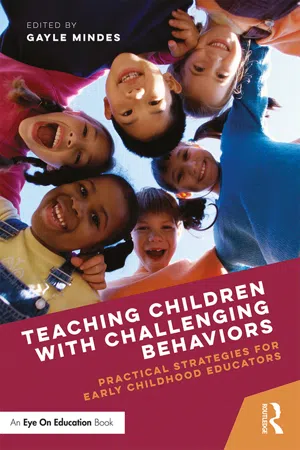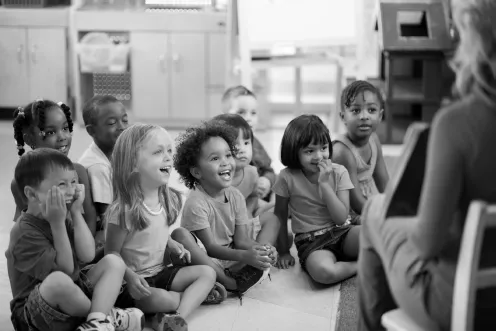![]()
1
Supporting Behavior and Learning for All Young Children
Gayle Mindes
In this chapter, we will look at classroom life, define challenging behavior, and discuss teacher responsibilities for the early childhood classrooms of today. The discussion emphasizes the critical role that teachers play in meeting learning outcomes, developing social competence in individual children, and maintaining a safe, secure environment for all children to learn and thrive. A definition of challenging behavior begins the chapter. Included topics are the high rate of expulsion of children from early childhood settings and the essential role for teachers in promoting self-empowerment of all learners.
Teaching Young Children in Classrooms
Children come to our classrooms with various social and emotional skills that manifest themselves in their behavior. As teachers, we are charged with facilitating behaviors that will lead to enhanced social competence with both individual behavioral skills and the capacity to function effectively in a community of learners. Classrooms are inherently social structures of relationships between teachers and individual children and among children. The way the social structure of the classroom plays out is influenced by children’s experiences in group settings and their cultural and family backgrounds. In addition, the social relationships are influenced by personal views of appropriate child behavior and the teacher’s confidence in their role. All of the social aspects occur within a philosophical orientation to program and curriculum wherein learning academics must occur.
Teachers in Charge
In the arena of social relationships and the school or child care center’s program goals and philosophy, the one immutable requirement is that the teacher must be in charge of the room—keeping order and safety firmly in mind. Thus, what vexes teachers the most is behavior that interferes in the work of the classroom—the learning for all young children. In this book, we will explore ways to deal with behavior that is difficult to manage, including the extremes of difficult behavior known as externalized challenging behavior.
Challenging behavior that is externalized is a child’s outburst and loss of self-control. For example, hitting others, kicking, screaming, and spitting are very challenging to handle in the classroom. The child exhibiting such behavior demands teacher attention—first so the child can be protected from potentially hurting self or others, and second to reassure the child who is behaving this way that the child’s perceived “threat” will stop.
Figure 1.1 Teacher leading a class discussion.
Extreme behavior is also frightening for other children in the classroom and difficult to manage. Unfortunately, too often many teachers are not successful in managing this difficult behavior—and often the solution is to remove the child from the situation.
Exclusion from Activities and Expulsion
When teachers are unable to manage children’s behavior, they often send children to a corner of the room, have an assistant remove the child who is out of control, and finally build a case for suspension and expulsion from the program. The statistics for expulsion from early childhood state-funded programs are three times higher than for K–12 schools. In 2008, there were 6.7 expulsions for every 1,000 preschoolers in these programs. The highest number of children were the ones at the older end of the continuum and African American boys. The numbers of young children expelled from private child care centers are even higher (Gilliam, 2008). We cannot continue to function in the best interest of young children by operating from an exclusion perspective. Young children and their families count on continuity of learning experiences for optimum child development.
Cost to Children, Families, and Teachers
The cost to children, families, and teachers for excluding children from child care settings is not simply a financial burden for families; it is most of all an emotional one. Families must deal with searching for a new child care arrangement, potential disruption of their own work schedule, comforting their children, and handling feelings of failure. All of these responses and necessary actions tax the family structure and affect a child’s ultimate successful learning in school. A joint policy statement by the US Department of Education and the US Department of Health and Human Services (2014) calls for early childhood educators to prevent and severely limit the suspension and expulsion of children from early childhood settings. Statistics from these agencies and others reveal that not only are young children suspended and excluded at higher rates than older elementary and high schoolers, but also the actions show racial and gender bias. In addition to the US Department of Education and US Department of Health and Human Services policy statement, the National Association for the Education for Young Children created the advocacy action statement: Standing together against suspension and expulsion in early childhood (2016), which highlights statistics, research, and action items related to teacher development and program sensitivity for all children. While being sensitive to children’s individual needs for social-emotional development, teachers today must meet program outcome requirements that may at times seem incongruent with attention to facilitation of children’s social and emotional skills.
Teachers Must Produce Outcomes
For teachers, the pressure to create the conditions for child success at any age is enormous. Teachers must balance the needs of individuals with the needs of the group. They must scaffold individual children to be effective learners and community members, while keeping potential chaos at bay. Teacher decisions must also be made at lightning speed. They must constantly ask themselves questions such as, what behavior can be ignored momentarily? Will the group tolerate Arthur’s hysterical crying for a few minutes while we are cleaning up? Can I verbally reassure Arthur from across the room? Will everyone burst into tears? Will they make fun of Arthur? Will a classmate go to Arthur’s aid? All of these possible scenarios will be affected by the teacher’s relationship with the group, each individual, the routines established, the ages of the children involved, and many other factors. For teachers, who must make these split-second intervene or don’t intervene decisions, on a daily basis, the balance of “smooth functioning” versus chaos determines whether learning occurs and whether teachers feel successful in meeting the requirements of the curriculum and the children they serve. If there is an imbalance in teachers’ perceptions of their capacities to organize, teach, nurture, and “manage the classroom” while coping with behavior that is challenging, there is the risk that highly qualified teachers hoping to make a difference in the lives of children will give up and leave the field.
Teachers Quit
The 2005 Spotlight: Mobility in the teacher workforce (2014) shows that one of the five most common reasons for leaving the field is problematic student behavior. One manifestation of teacher dissatisfaction is frustration and anger that may occur when a particular child cannot meet academic demands (Chang, 2009 in McCarthy, Lineback, & Reiser, 2014). The frustration and anger occurs based on the teacher’s perception of the situation. Thus, if the teacher sees that a child is messing around when a group lesson is being presented, they might perceive that the child is interfering with the learning goal for that time period and creating a group distraction. The feelings of frustration may be exacerbated when teachers cope by employing yelling, humiliation of children, group punishment, and showing negative attitudes toward individual students.
To combat feelings of frustration and anger toward children, teachers must have a number of tools, a great deal of knowledge about child behavior, and the capacity to reflect upon their practices. If teachers feel self-confident in their capacity to instruct, individualize, and to collaborate with children in advancing learning, they can be effective with children and secure in their effectiveness in managing the instruction and the child behavior. In this book, we will focus on the elements of setting the stage for learning success through the lens of putting behavior first, since it is disruptive behavior that saps teacher confidence and contributes to the reasons teachers opt out of the profession. In this way, we contribute to the development of each child’s social-emotional learning and self-efficacy as a learner in a social setting, and ultimately facilitate social competence.
Social Competence
For our purposes, then, what should we be thinking about regarding child behavior in the classroom? If we seek to create a productive learning environment, then we must both promote social competence, which is, broadly speaking, the ability of young children to get along with others. In the classroom, social competence is complicated with the requirement that each child must conform to the structure of the classroom, as well as interact with others who may not share the same cultural values and experiences.
Besides fostering social competence for children who have varying experiences in group situations and who are learning the ropes of school, teachers have to manage behavioral outbursts on a continuum from the merely annoying to those that are outright dangerous. These are not always easily solvable, but here we will discuss some ways of tackling the complexity of managing the classroom. The following scenarios depict some of the situations teachers might face on a daily basis.
Examples of Externalized Challenging Behaviors
Three-year-old Alessandra does not speak in her Head Start class, and she is not interested in any of the activities available during free play. She wanders the room with her hand outstretched, approaching her friends to pat them on the cheek or to scratch them. Neither the teacher nor the children know which action to expect. Alessandra’s behavior is unpredictable and thus challenging for both the children and the teacher: The children never know whether they will be hurt and the teacher is unsure what this behavior means to Alessandra. The children exclude her from their play and the teacher can’t always be by her side. What to do?
Harold, a 4-year-old in a child care center, rarely stops moving during his eight-hour day there. He shouts out when one of the two teachers reads a story to the group in the circle, knocks over his friends’ block structures, and runs out of the room. The teachers fret, because they are worried that they may not immediately see him running away—thus putting Harold in danger. Martha and Howard, Harold’s parents, are mystified about the teachers’ reports. They claim he is fine at home, although they are worried that he doesn’t get invitations to birthday parties and rarely gets requests to play at classmates’ homes. How can Harold’s parents and his teacher help him when they have totally different perceptions about his behaviors in school?
Figure 1.2 Example of an angry child.
First graders complain to Ms. Hawthorne that someone is pinching them and she can see bruises on their arms. The complaint often comes when the children are standing in line to go to recess or to specials. After several days of watching Lurleen and quizzing the children, she discovers that Lurleen is the culprit. In front of the children, she pulls Lurleen out of line and tells her in a firm voice: “You can’t pinch your friends. It hurts them. I am going to call your family, right after school. They will have to come to a conference with me.” The next day, Lurleen arrives at school, as usual, but she refuses to talk. She will not answer Ms. Hawthorne’s questions, read aloud, or talk to classmates in the classroom, although children report that she talks to them on the playground. This behavior continues for several weeks. A student teacher, Ms. Bell arrives; Ms. Hawthorne asks Ms. Bell to pretend that she doesn’t know that Lurleen is mute during class. As soon as Ms. Bell asks Lurleen to read, the other children in the group say: “She doesn’t talk.” How can Ms. Hawthorn help Lurleen? What resources does she have available to her in the school setting to assist her in assessing the situation?
In each of these scenarios, children are using behavior to express themselves. Sometimes it is immediately apparent as to why the behavior occurs; sometimes we may need to look more closely at the context and the behavior to figure out what is going on. Nevertheless, faced with these situations, each teacher must deal with the behavior expeditiously so that learning can occur for everyone.
Teachers Act Immediately
In each of these scenarios, teachers face child behavior that disrupts the class community. These are serious behaviors challenging the teacher to act quickly and responsively, so that the children exhibiting outbursts can learn the social skills necessary for classroom success and gain emotional security. Some of the behaviors are dangerous to the life of the classroom, as well as to the children in the setting. In other situations, teachers may see behaviors requiring immediate action, but the disruptions may be merely annoying, such as Sarah’s flicking of the lights on and off in the classroom during cleanup time. Always, teachers worry about contagion. They may worry whether other children “catch” the “bad” habits or whether there will be a revolt. No one will feel secure and safe when there is the possibility that the 3-year-olds are in charge, when children feel frightened of being hurt, or of losing their possessions, or having their toys broken. But most of all, teachers need to feel secure. They must be in charge, in control, effective in their relationships and in facilitating learning. Thus, as a teacher, you must learn how to manage the complexities of creating, maintaining, and individualizing an effective learning environment. In this way, you assure all the children in your care that they can be self-empowered learners.
Dealing with Challenging Behavior
In a classroom set up for learning, the adult (i.e., the teacher) must be in control of self and react with empathy, authority, and reassurance toward each individual child. Then, there is the rest of the class. The teacher must help the other children to feel safe, comfortable, and reassured that all will be calm in the classroom. In this way, children control their own behavior and children thrive in the learning community. While child behavior is the focus of this book and challenging behavior becomes center stage in any classroom, teachers are primarily accountable for meeting curricular outcomes. So, how do teachers do both—manage behavior and create a learning community for everyone? First, teachers must (and usually do) recognize challenging behavior, those incidents that disrupt the calm, engaging learning activities. Second, teachers must learn to effectively manage challenging behavior for the individual learner and the class as a whole. Teachers accomplish this feat by learning effective ways to identify triggers for individual child outbursts, as well as helping young children to gain increasing skill at self-efficacy in social situations. Then, everyone can be a learner.
As defined at the start of this chapter, externalized challenging behavior is loss of self-control by an individual child that must be dealt with immediately. So, in addition to the preceding anecdotes of children showing challenging behavior, extreme behaviors are those that offer a serious incident, such as throwing a chair at another child or adult; behaviors that are persistent, such as running around the classroom, refusing to sit in a seat, or screaming; or those that are intermittent, occurring occasionally with no apparent pattern, such as bursting into tears. All of these extreme behaviors require specialized intervention techniques or adjustments to the classroom environment. However, along the continuum of behavior there are other troubl...



